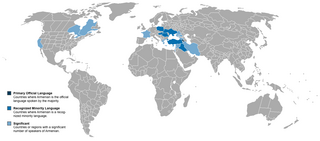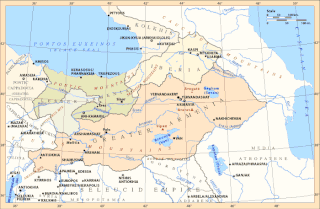
The Armenian language is an Indo-European language spoken primarily by Armenians. It is the official language of Armenia. Historically being spoken throughout the Armenian Highlands, today, Armenian is widely spoken throughout the Armenian diaspora. Armenian is written in its own writing system, the Armenian alphabet, introduced in 405 AD by Mesrop Mashtots.

Armenia lies in the highlands surrounding the Biblical mountains of Ararat. The original Armenian name for the country was Hayk, later Hayastan, translated as the land of Haik, and consisting of the name of the ancient Mesopotamian god Haya (ha-ià) and the Persian suffix '-stan' ("land"). The historical enemy of Hayk, Hayastan, was Bel, or in other words Baal.

The Armenian Genocide, also known as the Armenian Holocaust, was the Ottoman government's systematic extermination of 1.5 million Armenians, mostly citizens within the Ottoman Empire. The starting date is conventionally held to be 24 April 1915, the day that Ottoman authorities rounded up, arrested, and deported from Constantinople to the region of Ankara 235 to 270 Armenian intellectuals and community leaders, the majority of whom were eventually murdered. The genocide was carried out during and after World War I and implemented in two phases—the wholesale killing of the able-bodied male population through massacre and subjection of army conscripts to forced labour, followed by the deportation of women, children, the elderly, and the infirm on death marches leading to the Syrian Desert. Driven forward by military escorts, the deportees were deprived of food and water and subjected to periodic robbery, rape, and massacre. Other ethnic groups were similarly targeted for extermination in the Assyrian genocide and the Greek genocide, and their treatment is considered by some historians to be part of the same genocidal policy. Most Armenian diaspora communities around the world came into being as a direct result of the genocide.

The Armenian Apostolic Church is the national church of the Armenian people. Part of Oriental Orthodoxy, it is one of the most ancient Christian communities. The Kingdom of Armenia was the first state to adopt Christianity as its official religion under the rule of King Tiridates in the early 4th century. The church originated in the missions of Apostles Bartholomew and Thaddeus in the 1st century, according to tradition.

The Old City is a 0.9 square kilometers (0.35 sq mi) walled area within the modern city of Jerusalem.

Transcaucasia, or the South Caucasus, is a geographical region in the vicinity of the southern Caucasus Mountains on the border of Eastern Europe and Western Asia. Transcaucasia roughly corresponds to modern Georgia, Armenia, and Azerbaijan. Total area of these countries is about 186,100 square kilometres. Transcaucasia and Ciscaucasia together comprise the larger Caucasus geographical region that divides Eurasia.

Armenians are an ethnic group native to the Armenian Highlands.
Articles related to Armenia include:
Moxoene was a province of the ancient kingdom of Armenia, today in Van province, Turkey, as well as a feudal familial name c. 400–800, also known by the name Moghk or Mox, Moxq, Moxus, Moxos, Moks, Mukus, Miks, Mikus, sometimes Mekes, as Muksî or Muskî in Kurdish, today Bahçesaray in Turkish.
The settlement was known in Roman times as Moxos, after the 8th century as Mokks or Moks, and after the 18th century as Mukus.

Classical Armenian is the oldest attested form of the Armenian language. It was first written down at the beginning of the 5th century, and all Armenian literature from then through the 18th century is in Classical Armenian. Many ancient manuscripts originally written in Ancient Greek, Persian, Hebrew, Syriac and Latin survive only in Armenian translation.
The Armenian calendar is the calendar traditionally used in Armenia.

The Satrapy of Armenia (Armenian: Սատրապական Հայաստան Satrapakan Hayastan; Old Persian: Armina or Arminiya, a region controlled by the Orontid Dynasty was one of the satrapies of the Achaemenid Empire in the 6th century BC, which later became an independent kingdom. Its capitals were Tushpa and later Erebuni.
The name Armenia enters English via Latin, from Ancient Greek Ἀρμενία.
The Armenian endonym for the Armenian people and country is hayer and hayk’, respectively. The exact etymology of the name is unknown, and there are various speculative attempts to connect it to older toponyms or ethnonyms.

Proto-Armenian is the earlier, unattested stage of the Armenian language which has been reconstructed by linguists. As Armenian is the only known language of its branch of the Indo-European languages, the comparative method cannot be used to reconstruct its earlier stages. Instead, a combination of internal and external reconstruction, by reconstructions of Proto-Indo-European and other branches, has allowed linguists to piece together the earlier history of Armenian.
The modern territory of Armenia has been settled by human groups from the Lower Paleolithic to modern days. The first human traces are supported by the presence of Acheulean tools, generally close to the obsidian outcrops more than 1 million years ago. Middle and Upper Paleolithic settlements have also been identified such as at the Hovk 1 cave and the Trialetian culture. The sites of Aknashen and Aratashen in the Ararat plain region are believed to date to the Neolithic period. The Shulaveri-Shomu culture of the central Transcaucasus region is one of the earliest known prehistoric cultures in the area, carbon-dated to roughly 6000 - 4000 BC. The Shulaveri-Shomu culture in the area was succeeded by the Bronze Age Kura-Araxes culture, dated to the period of ca. 3400 - 2000 BC. The Kura-Araxes culture was then later succeeded by the Trialeti culture.

Roman Armenia refers to the rule of parts of Greater Armenia by the Roman Empire, from the 1st century AD to the end of Late Antiquity. While Armenia Minor had become a client state and incorporated into the Roman Empire proper during the 1st century AD, Greater Armenia remained an independent kingdom under the Arsacid dynasty. Throughout this period, Armenia remained a bone of contention between Rome and the Parthian Empire, as well as the Sasanian Empire that succeeded the latter, and the casus belli for several of the Roman–Persian Wars. Only in 114–118 was Emperor Trajan able to conquer and incorporate it as a short-lived province.

Urartu, which corresponds to the biblical mountains of Ararat, is the name of a geographical region commonly used as the exonym for the Iron Age kingdom also known by the modern rendition of its endonym, the Kingdom of Van, centered around Lake Van in the historic Armenian Highlands.

The Armenian Quarter is one of the four quarters of the walled Old City of Jerusalem. Located in the southwestern corner of the Old City, it can be accessed through the Zion Gate and Jaffa Gate. It occupies an area of 0.126 km², which is 14% of the Old City's total. In 2007, it had a population of 2,424. In both criteria, it is comparable to the Jewish Quarter. The Armenian Quarter is separated from the Christian Quarter by David Street and from the Jewish Quarter by Habad Street.











